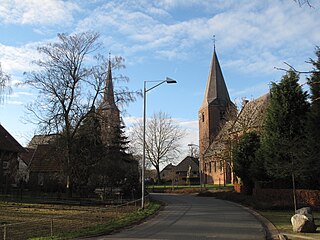
Haren is a town and a former municipality in the northeastern Netherlands. It is located in the direct urban area of the City of Groningen and, in January 2019, was merged into municipality of Groningen.

Horssen is a village in the Dutch province of Gelderland. It is a part of the municipality of Druten, and lies about 10 km northwest of Wijchen.

Eext is a village in the Dutch province of Drenthe. It is a part of the municipality of Aa en Hunze, and lies about 12 km east of Assen. There are three hunebedden (dolmen) near the village.

Anloo is a village in the Dutch province of Drenthe. It is a part of the municipality of Aa en Hunze, and lies about 10 km east of Assen.

Borger is a village in the Dutch province of Drenthe. It is a part of the municipality of Borger-Odoorn, and lies about 18 km east of Assen.

Bronneger is a small village in the Dutch province of Drenthe. It is a part of the municipality of Borger-Odoorn, and lies about 18 km east of Assen.

Drouwen is a village in the Dutch province of Drenthe. It is a part of the municipality of Borger-Odoorn, and lies about 17 km east of Assen.

Odoorn is a village in the Dutch province of Drenthe. It is a part of the municipality of Borger-Odoorn, and lies about nine km north of Emmen.

Valthe is a village in the Dutch province of Drenthe. It is a part of the municipality of Borger-Odoorn, and lies about 8 km north of Emmen.

Midlaren is a village in the Dutch province of Drenthe. It is a part of the municipality of Tynaarlo, and lies about 14 km southeast of Groningen.

Paterswolde is a village in the Dutch province of Drenthe. It is a part of the municipality of Tynaarlo, and lies about 8 km south of city of Groningen. Paterswolde and Eelde has merged into a single urban area, and are often referred to as Eelde-Paterswolde, however they remain separate villages.

Zeijen is a village in the Dutch province of Drenthe. It is a part of the municipality of Tynaarlo.

Farmsum is a village in the Dutch province of Groningen. It is a part of the municipality of Eemsdelta.

Weiwerd is a former village in the Dutch province of Groningen. It is a part of the municipality of Eemsdelta, and lies about 27 km east of Groningen.

Roden is a town in the Dutch province of Drenthe. It is located in the municipality of Noordenveld, about 16 km southwest of Groningen.

Loon is a village in the Netherlands and is part of the Assen municipality in Drenthe. The hunebed (dolmen) D15 is located near the village.

De Wilp is a village in the Netherlands south of the town of Marum. It is largely located in the municipality of Westerkwartier in the province of Groningen, but a few houses of the village are in the municipality of Opsterland in the province of Friesland.
Daan Reiziger is a Dutch professional footballer who plays as a goalkeeper for Eerste Divisie club Cambuur.

Echten is a village in the Dutch province of Drenthe and is part of the De Wolden municipality. The havezate Huis te Echten is located in the village.

Megalithic architecture appeared in what is now the Netherlands during the Neolithic period, especially in the northeast. Megalithic structures, i.e. buildings made of large upright stones, occur in various forms and functions, mainly as burial sites, temples or menhirs. In the Netherlands, only burial complexes are known. These large stone tombs were built between 3470 and 3250 BC by members of the Western Group of the Funnelbeaker culture (TBK) and were used until about 2760 BC. After the end of the Funnelbeaker culture in the Late Neolithic, the sites were reused by the Single Grave culture and the Bell Beaker culture during the ensuing Early Bronze Age and, to a lesser extent, into the Middle Ages.

























